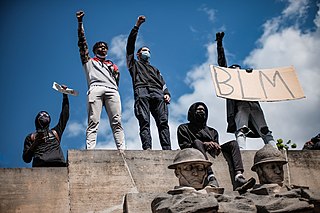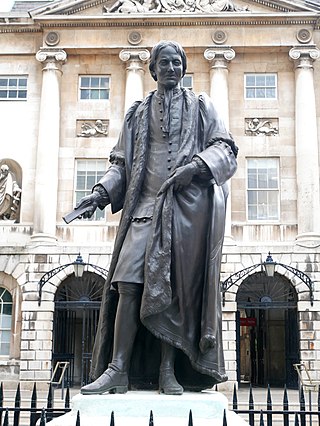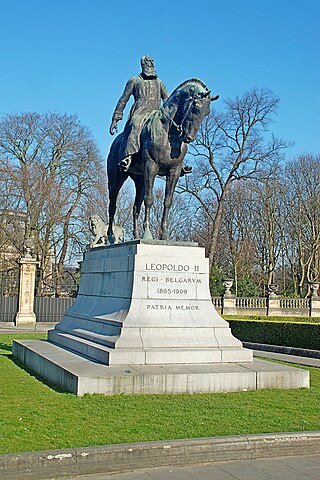
Leopold II was the second King of the Belgians from 1865 to 1909, and the founder and sole owner of the Congo Free State from 1885 to 1908.

Albert I was King of the Belgians from 23 December 1909 until his death in 1934. He is popularly referred to as the Knight King or Soldier King in Belgium in reference to his role during World War I.

The monarchy of Belgium is the constitutional and hereditary institution of the monarchical head of state of Belgium. As a popular monarchy, the Belgian monarch uses the title king/queen of the Belgians and serves as the country's head of state and commander-in-chief of the Belgian Armed Forces.

Prince Charles, Count of Flanders was a member of the Belgian royal family who served as regent of Belgium from 1944 until 1950, while a judicial commission investigated his elder brother, King Leopold III of Belgium, as to whether he betrayed the Allies of World War II by an allegedly premature surrender in 1940 and collaboration with the Nazis during the occupation of Belgium. Charles' regency ended when Leopold was allowed to return to Belgium. Shortly after returning and resuming his monarchical duties, Leopold abdicated in favour of his son, Baudouin.

The Cinquantenaire Arcade is a memorial arcade in the centre of the Parc du Cinquantenaire/Jubelpark in Brussels, Belgium. The centrepiece is a monumental triple arch known as the Cinquantenaire Arch. It is topped by a bronze quadriga sculptural group with a female charioteer, representing the Province of Brabant personified raising the national flag.

Thompson Elk Fountain, also known as the David P. Thompson Fountain, David P. Thompson Monument, Elk Fountain, the Thompson Elk, or simply Elk, was a historic fountain and bronze sculpture by American artist Roland Hinton Perry. The fountain with its statue was donated to the city of Portland, Oregon, United States, in 1900 for display in Downtown Portland's Plaza Blocks. It was owned by the City of Portland.
An outdoor 1992 bronze sculpture of Christopher Columbus by Joe Incrapera was installed in Houston's Bell Park, in the U.S. state of Texas. It was later removed in 2020 after a history of vandalism.

From 1885 to 1908, many atrocities were committed in the Congo Free State under the absolute rule of King Leopold II of Belgium. These atrocities were particularly associated with the labour policies, enforced by colonial administrators, used to collect natural rubber for export. Combined with epidemic disease, famine, and falling birth rates caused by these disruptions, the atrocities contributed to a sharp decline in the Congolese population. The magnitude of the population fall over the period is disputed, with modern estimates ranging from 1.5 million to 13 million. The atrocities have been variously referred to as the Rubber Terror and by some as the Congolese Genocide, though the latter characterization is disputed.

The George Floyd protests were a series of protests and demonstrations against police brutality that began in Minneapolis in the United States on May 26, 2020. The protests and civil unrest began in Minneapolis as reactions to the murder of George Floyd, a 46-year-old unarmed African American man, by city police during an arrest. They spread nationally and internationally. Veteran officer Derek Chauvin was recorded as kneeling on Floyd's neck for 9 minutes and 29 seconds; Floyd complained of not being able to breathe, but three other officers looked on and prevented passersby from intervening. Chauvin and the other three officers involved were later arrested. In April 2021, Chauvin was found guilty of second-degree murder, third-degree murder, and second-degree manslaughter. In June 2021, Chauvin was sentenced to 22+1⁄2 years in prison.

A statue of Edward W. Carmack was installed in Nashville, Tennessee, United States in 1924. The statue was the work of American sculptor Nancy Cox-McCormack. Carmack was an opponent of Ida B. Wells and encouraged retaliation for her support of the civil rights movement.

The equestrian statue of Leopold II is a monument erected in Ostend, Belgium, in memory of King Leopold II, second King of the Belgians. It is located on the Royal Galleries by the beach. The king was commemorated here as a benefactor of Ostend and the Belgian Congo. The inauguration was on 19 July 1931.

Shortly after protests seeking justice for George Floyd, an African-American who was murdered during a police arrest, began in the United States, some people in Belgium protested to show solidarity with Americans protestors and to demonstrate against issues with police or racism. Vigils and protests of up to thousands of participants took place nationwide.

A statue of Thomas Guy stands in the forecourt of Guy's Hospital in the borough of Southwark in Central London. The statue is Grade II listed.

A bronze statue of Captain John Fane Charles Hamilton was installed for seven years, in Hamilton, New Zealand, from in 2013 until removal in June 2020. The settlement of Hamilton was named after Captain Hamilton, a Royal Navy officer who was killed in action during the Battle of Gate Pā.

The Howitzer Monument was installed in Richmond, Virginia, in the United States. It commemorated the Richmond Howitzers, a Confederate artillery unit. The statue was created by Caspar Buberl. It was located on Virginia Commonwealth University's Monroe Park campus.
Belgian apologies to the Congo are the subject of a societal debate in Belgium over the expression of apologies for the role that country has played in the atrocities that have been committed in the Congo Free State and the Belgian Congo between 1885 and 1960, and the colony of Ruanda-Urundi (1924–1962).

The equestrian statue of Leopold II is a bronze equestrian statue erected in Brussels, Belgium, in memory of King Leopold II, second King of the Belgians. It was created by the sculptor Thomas Vinçotte in 1914, but it was not finalised until 1926 by the architect François Malfait, when it was inaugurated in honour of the king.

The Monument to the Dynasty is a monument erected in Brussels, Belgium, in memory of King Leopold I, first King of the Belgians. The monument is located in Laeken Park, on the Place de la Dynastie/Vorstenhuisplein, on top of a 50-metre-high (160 ft) hill. It completes the monumental axis, which starts from the portal of the Royal Palace of Laeken, and which leads to the monument after crossing the Avenue du Parc Royal/Koninklijk Parklaan via the Avenue de la Dynastie/Vorstenhuislaan.
















